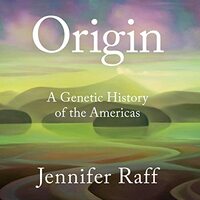You need to sign in or sign up before continuing.
Take a photo of a barcode or cover
challenging
informative
medium-paced
The peopling of North and South America (and lands in between and adjacent!) was once a simple and straightforward story. People came over the Bering Land Bridge as soon as the ice melted and populated this virgin land.
[a:Jennifer Raff|20392716|Jennifer Raff|https://s.gr-assets.com/assets/nophoto/user/u_50x66-632230dc9882b4352d753eedf9396530.png] has a few things to say about that. Many things, in fact. Backed by a mixture of genetics and archaeology she will slowly but surely blow your mind and clear out those old Bering Land Bridge cobwebs. And take you on a fascinating journey besides.
Dr. Raff also presents a caring heart for the cultures her work impacts. And a deep understanding of their willingness and reluctance to participate in her research. That is as an important takeaway from this book as the research itself.
[a:Jennifer Raff|20392716|Jennifer Raff|https://s.gr-assets.com/assets/nophoto/user/u_50x66-632230dc9882b4352d753eedf9396530.png] has a few things to say about that. Many things, in fact. Backed by a mixture of genetics and archaeology she will slowly but surely blow your mind and clear out those old Bering Land Bridge cobwebs. And take you on a fascinating journey besides.
Dr. Raff also presents a caring heart for the cultures her work impacts. And a deep understanding of their willingness and reluctance to participate in her research. That is as an important takeaway from this book as the research itself.
emotional
informative
reflective
medium-paced
challenging
informative
slow-paced
Editing my earlier comments:
I did end up coming back and finishing this book. Fortunately, the sidebars that I had found interesting but disruptive in Part 1 were used more sparingly in the rest of the book. I still struggled with the author’s writing style, but I came away with a broad understanding of the subject and a desire to continue reading about the early peopling of the Americas.
Original Comments
I read through the end of Part 1 before deciding this book wasn't for me. Based on other reviews, I had expected that the writing would be more accessible to a lay audience, but it seems a reader would benefit from some basic familiarity with the field. It was a little over my head at times and I found myself having trouble retaining the information.
Also, each chapter contains multiple side bars, which were interesting, but the placement was often disruptive to the overall reading experience. I wish the author or editor could have found a way to incorporate those details into the main narrative.
I did end up coming back and finishing this book. Fortunately, the sidebars that I had found interesting but disruptive in Part 1 were used more sparingly in the rest of the book. I still struggled with the author’s writing style, but I came away with a broad understanding of the subject and a desire to continue reading about the early peopling of the Americas.
Original Comments
I read through the end of Part 1 before deciding this book wasn't for me. Based on other reviews, I had expected that the writing would be more accessible to a lay audience, but it seems a reader would benefit from some basic familiarity with the field. It was a little over my head at times and I found myself having trouble retaining the information.
Also, each chapter contains multiple side bars, which were interesting, but the placement was often disruptive to the overall reading experience. I wish the author or editor could have found a way to incorporate those details into the main narrative.
challenging
informative
reflective
medium-paced
There is a certain section of humanity's past where genetic studied can reveal new information. Raff's book brings some of that information to the general public, I really enjoyed it.
challenging
slow-paced
So much of this book has nothing at all to do with the premise of it and the constant sermonising about white colonization that takes up the first 30% of the book has nothing at all to do with genetics or native origins and has no place in this book.
informative
reflective
medium-paced
informative
reflective
medium-paced
I think Origin was a really great blend of layman explanations and extra depth for people a bit more scientifically inclined. This topic/field really interests me, so the book was a quick and easy read for me. Learning about how scientists use the molecular mutational clock, haplogroups, SNPs, etc. to estimate population origins and then correlate that with archeological sites and lithics to make population models was the coolest part to me. Understanding the history of the field and how that plays into today’s ethical considerations is also an important feature of the book. The only critique is that I felt like she left us hanging on what ever happened with her findings in chapter 5, and in chapter 8 with the Utqiagvik cemetery samples.


